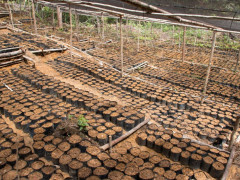Community Involvement Is Key to the Success of Peat Restoration
By Admin Pantau GambutPeatland Ancestors
Like humans, peat also has an origin. Peat is generally known as organic sediment built up by decayed plant and animal remains that have been buried for thousands of years.
The first peat layers were formed roughly 5,000-10,000 years ago. Meanwhile, peat in Indonesia is estimated to have begun forming 4,200-6,800 years ago.
These stacked layers can reach up to 10-15 meters deep. However, it takes at least 2,000 years to form just 4 meters of peat.
The peat formation process began in shallow lakes overgrown with aquatic plants or dead and decayed wetland vegetation, which later formed a layer of organic material at the bottom of the lake. Over time, layer-by-layer, peat formed on top of the mineral-rich soil on the lake floor. These peat layers covering lake floors are called topogenous peat.
The first two meters is called topogenous peat, which has a layer of fertile soil and low acidity. At particular times, such as during major floods, minerals quantities are enriched, and this peat become more fertile.
The next layer is ombrogenous peat, which lies on top of the topogenous peat layer. This layer is more dense than the lake surface, creating a dome shape. Ombrogenous peat has less nutrients than the layer below, because rain water acts as a soil cleaner during its formation.
Peat is divided into three types based on its origin. Sedimentary peat is made from wet soil; fibrous peat consists of sphagnum plants and grass; and woody peat comes from trees and bushes. In Indonesia, most peatland consists of woody peat.
Additionally, peat can be distinguished by its fertility. Eutrophic peat is the most fertile; it is rich in minerals and other nutrients. Mesotrophic peat is moderately fertile, because it has mineral contents and some nutrients. Oligotrophic peat is infertile; it has few minerals and some nutrients. Most peatland in Indonesia is mesotrophic or oligotrophic.
Peat formation processes also vary by location. Peat formed in coastal areas – called coastal peat – obtains mineral enrichment from the seawater. Inland peat is formed in areas with rainfall that are unaffected by tides. Peat formed between these two environments is called transition peat.
Regardless of its type, peat has certain common physical characteristics that need to be accommodated for optimal agricultural use. Peat contains 100-1300% of its dry weight in water. In other words, peat can absorb up to 13 times its weight in water. To some extent, peat can even channel water to surrounding area.
Nevertheless, the high water content of peat can make the surface muddy and unable to hold weight. Consequently, it can be difficult to stand firmly on peatland.
The volume of peat shrinks when it is dried, causing land subsidence. Therefore, it is important that drainage system planning also considers the unique characteristics of peatland.
Once dried out, peat has difficulty reabsorbing water.
Another characteristic of peat that requires attention is its susceptibility to irreversible drying. Once dried out, peat has difficulty reabsorbing water. In this way it is similar to dry wood, which easily floats and burns in dry weather. It is this characteristic of peat that makes it the most frequent cause of forest and land fires, and it is for this reason that we ought to try to restore peatland after it has been burned.
If we understand peat’s origins, types, and characteristics as described above, we can realize the full potential of peatlands and avoid any further damage that might endanger the survival of peat ecosystems.
Source: World Agro Forestry




